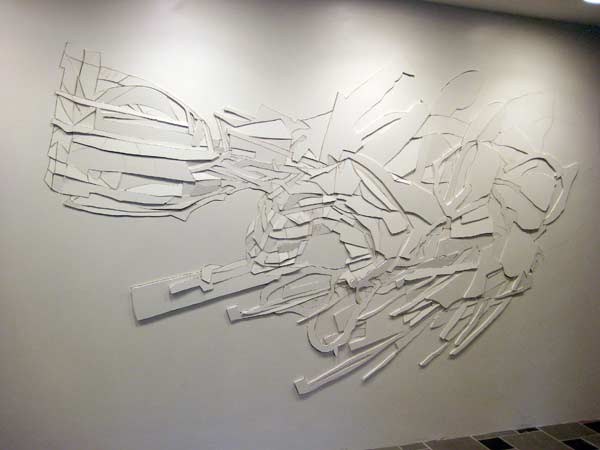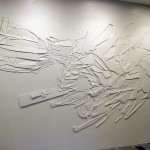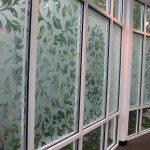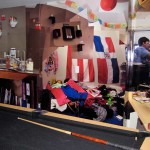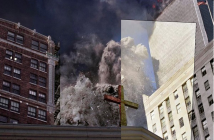GETTING SITE SPECIFIC @ BABSON COLLEGE
When Chris Nau invited me out to see his latest piece at Babson College, I was a little surprised. Babson is not known for contemporary art, and their gallery was turned into a café. Yet, visiting artist Danielle Krcmar has been working feverishly for four years to install work throughout the campus, and expose the business school students to new and interesting art.
"I think some students are really receptive, they know that just business, just money is not the end-all-be-all. Some do get surprised. But then there is the percentage of the population that think it's irrelevant. That's our job, to keep chipping away..." Krcmar says.
On a rainy Thursday, I traveled with Nau and Jon Shore (of LaMontagne Gallery) to meet with Krcmar. We checked out three pieces on campus, including Nau's new work "Inhabitat XIV". Like many of Nau's pieces, this one is cut directly out of the drywall and carefully shaped into a relief, with a few stray pencil marks and jagged jigsaw cuts.
"I start with a model, they are abstractions based on photographs of machines and animals, usually," Nau says of the drawing, which is very anthropomorphic and seems to change from machine to beast and back again the longer one looks. "I was really kind of surprised at how exciting it was to do it here, because it's a non-gallery space. You're going to get people coming through here who aren't looking for this. Also, I like what it brings to the other objects in the space because this is really a business school dorm, and there's no other art in here and it's a really clean, corporate space."
That's right, "Inhabitant XIV" is cut out of the wall of the lobby of a residence hall. As we talk, workers come and go from a lounge, preparing for the influx of students in the fall. This residence hall is newly built, so only senior students will live there, but Nau knows his work may not be treated with the same delicate hands it would in an art-conscious setting. "There was a holiday while we were installing," he laughs. "There were two girls coming by with 30-packs of Old Milwaukee."
Installing work in such a setting is not without its rewards, particularly given Krcmar's goal of introducing students to art who might not otherwise go out of their way to meet artists and live with contemporary art. "I think that there were a lot of comments, as people were seeing the level of work that went into it. There was a sort of fascination about how all the things were going to come back together."
Nau smiles. "I got a really good comment from a senior walking through one day. He said the thing was fucking sick. I think that's the highest compliment I've gotten."
Nearby, in the student lounge, is another site-specific piece by Douglas Weathersby. Best known for his work as Environmental Services, Weathersby often makes pieces for which he is hired to perform a service (often construction or carpentry), and utilizes both the site of the work and the detritus of the labor to create temporary installations that speak about our expectations of art and how we perceive the working class. At Babson, however, Weathersby has taken a different approach.
The piece is a large montage of photographs, taken inside dorm rooms of Babson students. These images have been enlarged and installed along a pair of walls, overlapping and merging to create a sort of über-dorm-room. Because the piece resides in a student lounge, a pool table and chairs sit in front of it, enhancing and augmenting the imagery.
"I had seen Douglas' Virtual Home Office projects," Krcmar says, "and I love the idea of, especially at a business school, of the fact that Douglas is really this small-scale entrepreneur. He's asking these questions about art and business, and about who serves you. When you're dealing with a class of students are intending to be upper class, not working class, the question of who does service work and what does that mean. We talked a lot about that."
We meander in the rain across campus, to check out a piece from 2006 by Samantha Fields. In a narrow, glass-walled corridor, Fields has created beautiful patterns covering the windows by cutting into frosted contact paper. Moving along the walkway, abstracted forms of the trees outside glimmer through strange repetitive forms, a seamless intrusion. Krcmar notes that the piece is incomplete in its current form, as half of the panels were removed for exhibition at the DeCordova Museum, and a hanging curtain is no longer installed. Still, the effect of the piece is overwhelmingly beautiful and welcoming, perfectly at home in a corridor passing between an office space that feels like a hospital and a student union that feels like an airport.
Asked about the audience for the work, Krcmar points out that the nature of the campus makes viewing, especially for non-students, a challenge. "We are a safe campus, but they're not guarded. We have a specific audience, but they are somewhat public work. It's not private, it's not public..." She is quick to point out, however, that anyone can view the work by contacting her through the Babson website and arranging a tour.
Leaving Babson, I was left with a lot of thoughts regarding the work I had seen, and the role a program like Krcmar's plays within a school that clearly wants to engage with contemporary art and yet does not have a large arts program in its curriculum. By placing these works in the living areas and domestic spaces of the students, I think many boundaries are broken down, in terms of expectations and understanding of artists and their work. Nau spoke repeatedly of interactions he had with students, who would ask questions while he was creating the piece but remained silent at artist talks after it was finished. Krcmar often noted the importance of challenging preconceptions about art ("It's all painting...") and how artists like Weathersby, Nau and Fields have done that with their installations.
As a site for works like these, Babson is an unexpected host but Danielle Krcmar placing really interesting pieces in odd contexts. Just as important is the impact this work will have on the students of Babson, who are hopefully on their way to creating their own private and corporate collections.
- Chris Nau, Inhabitat XVI, pencil and cut drywall, 2008.
- Samantha Fields, no place like home, contact film on glass, 2006.
- Douglas Weathersby, The Human Nesting Project, digital prints, 2008.
All images are courtesy of the artists and Babson College.
Images by the author.

